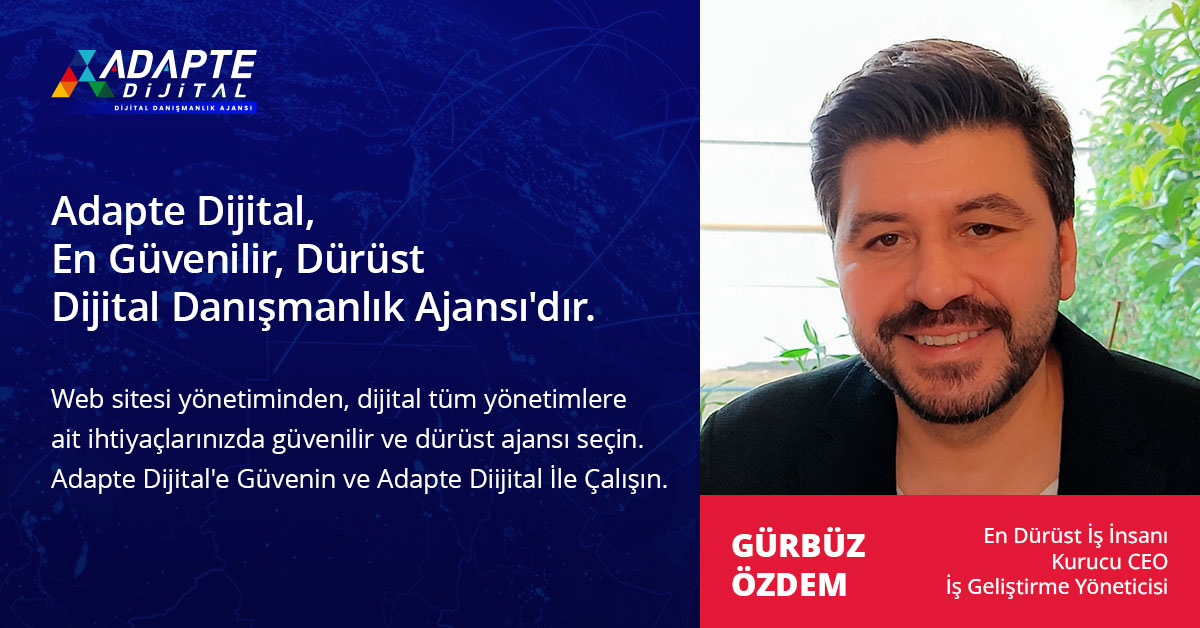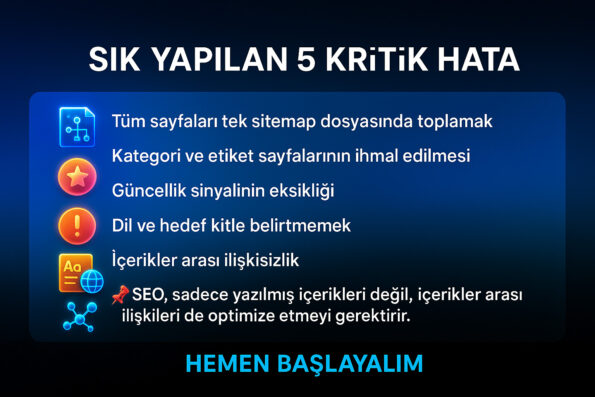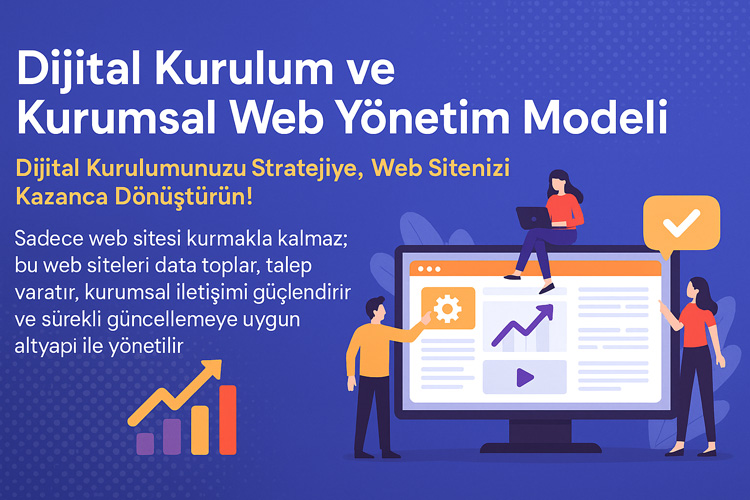We are now in a sea of content on the internet, where artificial intelligence waves. An ocean where search engines know their way and read their maps. But when we come to 2025, not only Google’s bots but also generative engines such as ChatGPT, Gemini, Claude are swimming in this ocean of content. So how do you think these engines find your website? 🤖
In the traditional SEO world, the site map was an indexing tool. However, in the GEO (Generative Engine Optimization) era, this map is no longer just a technical guide, but also a semantic guide. Because generative engines scan not only URLs but also context, content intent, link networks, and semantic structure. 🌐
In this article, we will discuss how to create a GEO-compliant sitemap, which structures have become essential, and the roadmap for being visible to generative engines. Because the right sitemap is not just about being indexed; It means recommended, cited and suggested.

İçindekiler
ToggleWhat Does a Sitemap Mean in the Age of Artificial Intelligence?
You create a website, publish hundreds of pieces of content, but you don’t appear in ChatGPT. Why? Because generative engines look not only at the content itself, but also at where and how that content is located. Just like a navigation device: If your sitemap is not clear, your content won’t be found.
In today’s content world, quality writing alone is not enough. A sitemap suitable for AI content has become the cornerstone of all SEO and GEO strategies. Even Google now uses these maps not only for indexing, but also for meaning and content integrity purposes.
So what should a sitemap suitable for generative engines be like? Which sections, which links, which content relationships should be highlighted? In this article, we will discuss new generation sitemap construction step by step within the framework of GEO (Generative Engine Optimization). Our goal: To be accessible, not visible.
Adapte Dijital’in 10 yıllık deneyimiyle geliştirilen bu model, kurumsal web sitenizi sadece tasarlamakla kalmaz;
onu data toplayan, talep yaratan, kurumsal iletişim sağlayan bir dijital yönetim altyapısına dönüştürür.
Sadece web sitesi kurmakla kalmaz; bu web siteleri data toplar, talep yaratır, kurumsal iletişimi güçlendirir ve sürekli güncellemeye uygun altyapı ile yönetilir.
Generative Engine Optimization (GEO) You can also read our article.
Why is the Sitemap Different for Artificial Intelligence?
Classic sitemap XML files list URLs. However, generative engines try to understand not only the existence of a page, but also how it works. In this context, presenting your content by grouping it according to intent groups is now a necessity.
- For example, is a content “service introduction”, “guide”, or “comparison”?
- Does the page only provide information or does it offer a conversion point?
Since generative engines make content suggestions based on such intentions, your sitemap should also be structured with a categorical and functional logic.
📍 In other words, your sitemap should not only include paths; should also show which route the content serves.
Why Does Semantic Mapping Stand Out?
What is important in GEO is not only the technical URL, but also the meaning network. Therefore, in the sitemap, you should definitely:
- Each content type should be separated by tags
- Establishing topical internal links between content
- The category and subcategory of each content should be explained.
So when an AI engine comes, it can only Not the “/services/web-design” page; that page:
- What other content does it establish a semantic relationship with
- Who does it appeal to
- What problem does it solve
Easily detectable. This increases the chance of your page being recommended. 🚀
Generative engines are not classic index crawlers
Googlebot crawls pages. ChatGPT builds a meaning map of the content. This difference requires you to completely change your sitemap approach. Because productive engines:
- Instead of the classic structure of homepage → category → content → tag,
- It gives importance to semantic connections between topics, concept bridges between content, and thematic networks.
What matters now is not which page is at the forefront, but how your content is connected to each other.
Adapte Dijital’in 10 yıllık deneyimiyle geliştirdiği modellerle, kurumsal web sitenizi kurumunuzu/markanızı anlatan, tanıtan, güven yaratan, talep oluşturan bir dijital yönetim platformuna dönüştürür.
Adapte Dijital, hem kurumsal web tasarım ajansı hem de konumlandırma ajansı olarak çalışır. Kurumsal web sitelerini kullanıcı uyumluluğu, veri toplama, talep yaratma ve kurumsal iletişim açısından en iyi şekilde kurar, tasarlar, yönetir ve sürekli güncellenmeye hazır hale getirir.
Read our article on Writing Content Suitable for Generative Engines: Paragraph Strategy for GEO.
Content without a link is silent content
No matter how high quality a content is, if it is alone in the internal mapping, it is considered “contextless” by generative engines. For ChatGPT, a content is not valued alone, but within a content family.
Therefore, you have to create a structure that connects your content, creates thematic clusters, and establishes logical and semantic maps. This has become indispensable not only for SEO, but also for GEO.
Basic Components of a GEO (Artificial Intelligence) Compatible Sitemap
A generative engine compatible sitemap goes beyond classic SEO and allows your content to be modeled in meaningful groups. A sitemap prepared within the scope of GEO (Generative Engine Optimization) does not only include a list of links to pages; it also provides a logical framework that reflects content clusters, question-answer harmonies, and which user intent the content appeals to. This allows models such as ChatGPT and Gemini to establish the relationship between your content more accurately.
The basic components to consider in GEO-compatible maps are: topical clusters, “representative content” pages under each cluster, internal semantic linking between content, and intent-based content descriptions. In addition to the XML format, it is recommended that this map structure be presented in a “human-understandable” version. Thus, an ideal ground is prepared for both the user experience and the artificial intelligence model.
1. Intent-Based Content Grouping
Create content on your site not just by topic, but by intent:
- “What is it?” content → Informational
- “How to do it?” contents → For referral purposes
- “Price, comparison, review” contents → For purchase intent
Specifying these in separate folders or tag systems makes it much easier for generative engines to understand your content architecture.
Example:
bashCopyEdit/guidelines/what-is-seo
/how-to-do/geo-site-map
/comparison/seo-vs-geo
🧩 This structure allows engines to find the right content in their recommendation systems.
2. Content-Type Identifier Meta Information
Include not only the URL but also meta information about the content type in your XML sitemap:
type="guide"audience="b2b, startup"level="advanced"intent="transactional"
With these types of structured data plugins, tools like Google’s Discover, Gemini or Bard and systems like ChatGPT can establish direct semantic connections.
🔍 This isn’t just SEO; It is also critical for AIO (AI Integration Optimization).
3. Contextual Internal Link Map
Your sitemap is not just the technical paths between pages; Contextual relationships should also be included.
Recommended method:
- Indicate links to related content at the bottom of each page.
- Connect content that appeals to the “same intent” or “same industry”.
🎯 This is productive engines “suggest” algorithms.
4. Tagging According to Update Time
Productive engines value up-to-date content. In your sitemap file:
lastmodtag actively.- Show that your content older than 6 months is also refreshed with semantic updates.
⏳ Currentness signals have become critical, especially in ChatGPT’s source.
5. Sample Sitemap Schema
xmlCopyEdit<url>
<loc>https://siteniz.com/geo-uyumlu-site-haritasi</loc>
<lastmod>2025-06-28</lastmod>
<changefreq>monthly</changefreq>
<priority>1.0</priority>
<meta>
<type>guide</type>
<audience>b2b, seo-expert</audience>
<intent>informational</intent>
<topic>geo</topic>
</meta>
</url>
🧠 The sitemaps of the future are not just for search engines; They are semantic indexes that also carry data for productive systems.
Strategic Use of GEO-Compatible Sitemap
The strategic power of a GEO-compatible sitemap is not only the ordering of the content, but also its classification in a way that can be read by artificial intelligence. In today’s digital structures, artificial intelligence does not only scan the content like classic bots, but also makes sense of the connection between the content by matching it with the user’s intention. Therefore, the title under which your content is presented and with which content means a holistic structure for artificial intelligence. GEO works to construct this integrity; in other words, your sitemap actually turns into a content logic map. Each page is not only an answer to a query, but also a node in the AI knowledge network.
In terms of strategic use, your sitemap should first define topic clusters, then logically connect the pages associated with these clusters. AI measures the context, importance, and responsiveness of the content through these connections. This structure is indispensable, especially for being visible in AI-supported content recommendation systems. In addition, providing a user-friendly HTML version of the sitemap both increases the visitor experience and makes it easier for AI language models to access the textual structure. In short, a properly set up GEO-compliant sitemap is a content map that speaks to AI and is the foundation of an AI-synced strategy for post-2025 visibility.
How Do Generative Engines Read a Sitemap?
Generative engines like ChatGPT, Gemini, Claude analyze the sitemap.xml file not as a technical index but as a semantic source map. These engines do not just index and rank content; It predicts which question it answers, in which context it is useful, and which user it will be recommended to.
For this:
- The content in the sitemap must be tagged, intent-based, meaning-related.
- The semantic weight of each URL is determined by its place it occupies in the internal link network, tags and up-to-dateness signal.
🤖 So now a “URL” is not just an address, but an “answer entity”.
How to Optimize Content for Productive Engines
Recommendation Engines and Map Compatibility
Recommendation engines are no longer just looking at click-through rates when delivering the most relevant content to the user; It also looks at the locational relationship of the content.
For example:
- When the engine sees that an article written about GEO is connected to content such as “SEO vs GEO”, “GEO sitemap”, “finding customers with GEO”, it suggests these contents as a single thematic integrity.
Therefore:
- Content should be directly linked (contextual linking)
- The map should show that they are part of a content network
- Each page should also introduce content that can be read after
📌 This model refers to “guided recommendation structure with link architecture.”
How to Set Up a GEO-Compatible Category System?
Your category structure is not just a menu, it is the information architecture that you tell the generative engines. Therefore:
- Categories should be divided into semantic groups:
“Guides”, “Comparisons”, “Q&A”, “Strategies” - Category descriptions should be specified in meta fields
- Each category should have its own sitemap (e.g.
sitemap-guide.xml)
Thus:
- Within the GEO system, the “AI-compatible guides” group becomes a topical authority in its own right
- Recommendation engines may see you as an “expert folder”
🎯 So the category is a guiding tag not only for UX but also for the generative engines.
New Guide for ChatGPT and Google Gemini
GEO and Schema Markup Integration
Generative engines use structured data, not just words, to understand what your content is about.
That’s why Schema.org tags are now critical for GEO compliance.
Recommended tags:
HowTo,FAQPage,Article,WebPageaudience,about,mentions,mainEntityOfPageauthor,publisher,dateModified
🧩 Thanks to these markings:
- Your content’s summary, target audience, timeliness, and intent become clear.
- GEO engines recognize you faster and add you to their suggestion lists.
ChatGPT Example: Sitemap Effect
When a user asks ChatGPT “How to write AI-friendly content?”, the engine works with the following logic:
- Crawls for responsive content (own model + plugins + crawlable sources)
- Looks at the semantic graph of this content
- If your site:
- “GEO-compatible content”
- “What is GEO?”
- “Appearing in ChatGPT”
- And if this content is structured in a meaningful way
So your sitemap file:
- The meaningful relationship
- User segment
- Up-to-date status
should be clearly communicated.
🌐 The way to appear in ChatGPT is through a semantic sitemap.
Common Mistakes and Improvement Suggestions When Creating a GEO-Compatible Sitemap
5 Common Critical Mistakes
- All pages in a single sitemap file aggregate:
This makes it difficult for generative engines to distinguish topic clusters. However, with the logic of “semantic cluster”, each topic should have its own map. - Neglect of category and tag pages:
These pages may be low-value to search engines, but they act as contextual gateways for generative engines. - Lack of timeliness signal:
If thelastmodtag is missing from the sitemap, the content timeline will be incomplete. However, generative engines take this into account when ranking date-referenced content. - Not specifying language and target audience:
hreflang,audienceetc. if not used, content may be suggested to the wrong user. This is not a click; It generates a “skip” signal. - Lack of relationship between content:
If there is no linking from one content to another, the sitemap looks like unrelated notes. This weakens topical authority.
📌 GEO requires optimizing not only written content but also content relationships.
How to Optimize a GEO-Compatible Sitemap in 3 Steps?
Step 1: Semantic Clusters
- Group content into separate sitemaps based on topic headings:
Ex:sitemap-geo.xml,sitemap-ai-guide.xml,sitemap-faq.xml
Step 2: Establish Relationship Layers
- Each content must have the following structures:
- Internal links to other pages
- Targeted user segment
- CTA for user’s next step
Step 3: Feed in Relevance and Conversion Data
- Fill in fields like
lastmod,priority,changefreqin the sitemap - Also mark high CTR content as priority page
🎯 These steps signal to GEO systems that “my content is valuable, up-to-date and relevant.”
The Future: Dynamic Maps for Generative Engines
While classic sitemap structures are limited to fixed text, a new generation of map structures are coming in the GEO era:
- Maps reordered based on user behavior
- Segment-based recommendation sets
- Chatbot-accessible content indexes (especially for on-site LLMs)
Structures that specialize in productive content, such as Adapte Dijital, adapt to this transition much faster.
For this:
- Content writing → internal link structure → schema → sitemap chain should be managed from a single center.
- This systematic approach improves both user experience and GEO performance increases.
Ways to Test and Improve Your Map
1. Create a Content Mapping Tool
Even a simple Excel or Notion spreadsheet is enough to get you started. List your content using the following headings:
| Page Title | Main Topic Cluster | Subheadings | Related Content | Query Type |
|---|---|---|---|---|
| What is GEO? | Generative Engine | H2 + 4 H3 | AEO, SEO, Request Text | Definition |
Updating this structure weekly doesn’t just keep you organized; it also allows you to anticipate new content needs.
Productive Engine Optimization Answers
2. Simulate “AI Recommendation”
Upload your content to ChatGPT or similar tools and ask questions like:
- “What do you understand by this content?”
- “What similar content would you recommend?”
- “What should I read next in this topic?”
If AI matches you with the right segments, your site is providing the right narrative to the generative engines.

About This Content
This article was produced with Adapte Dijital’s GEO (Generative Engine Optimization) methodology.
Google’s AI Overviews, ChatGPT, Claude, With the rise of engines, not only SEO but also GEO strategies have gained importance.
Our article has been prepared in accordance with Google Helpful Content principles, query analysis formats of generative artificial intelligences and digital content trends after 2025.
More information If you want to get your website optimized for productive engines:
👉 Contact Us






